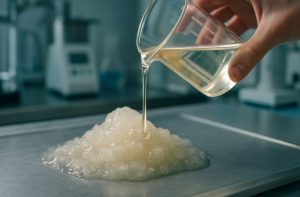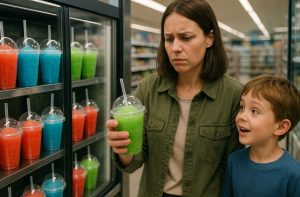What could be more innocent than a colourful, icy drink on a warm day? Slushies are often marketed as fun, fruity treats for children, particularly during summer months.
But behind the bright colours and frosty appeal lies a growing body of medical evidence that suggests slushies may not be as harmless as they appear especially for younger children. So what makes these drinks potentially dangerous, and at what age can they be consumed safely?
Recent studies and warnings from health agencies such as the Food Standards Agency (FSA) and Food Standards Scotland (FSS) have drawn attention to the risks posed by a key ingredient in many commercial slush drinks: glycerol. From hospital visits to neurological symptoms, the impact on children’s health can be more serious than many parents realise.
What Is Glycerol and Why Is It Used in Slush Drinks?

Glycerol, also known as E422, is a naturally occurring compound often used in food and beverage production. In slushies, glycerol serves a specific purpose, it helps maintain the semi-frozen texture by lowering the freezing point of the liquid. Without it, the drink would solidify, making it difficult to consume.
Unlike sugar, glycerol is not always clearly labelled or well understood by consumers. It is considered low in toxicity and is authorised for use in food and drinks under Regulation (EC) 1333/2008, with the stipulation that it must be used in accordance with good manufacturing practice.
However, this classification assumes moderate use and doesn’t account for the unique metabolic vulnerabilities of young children, particularly when slushies are consumed rapidly or in large quantities.
The concern arises not from glycerol’s presence alone, but from the levels used in some slush drinks and the frequency with which children consume them. A typical slush drink can contain up to 50,000 mg/L of glycerol, and portion sizes of 300–400ml are not uncommon, especially with the availability of free refills in some venues.
How Does Glycerol Affect a Child’s Body?
While glycerol is absorbed and metabolised by the liver, children process this compound differently from adults due to their smaller body size and developing organs. In young children, high levels of glycerol can lead to a condition known as glycerol intoxication, which has been documented in several UK and Irish hospital cases.
Between 2018 and 2024, a study published in the Archives of Disease in Childhood examined 21 children aged between two and seven who required emergency treatment shortly after drinking a slushie. These children displayed various symptoms, including:
- Loss of consciousness
- Seizures
- Hypoglycaemia (low blood sugar)
- High blood acidity (metabolic acidosis)
- Nausea and vomiting
In some instances, children were admitted to accident and emergency departments within an hour of drinking the slushie. Four children underwent brain scans, and one suffered a seizure.
While all recovered, the study’s lead author, Professor Ellen Crushell, warned that these cases likely represent just a fraction of those affected. Many children may experience milder symptoms such as dizziness or nausea that do not result in hospitalisation but still indicate harmful exposure.
What Are the Official Guidelines on Slushie Consumption for Children?

Previously, the Food Standards Agency advised that slush drinks should not be given to children under five, with those under 11 limited to one drink.
However, due to mounting evidence and increased hospital admissions, many researchers and paediatricians are now urging a change in the official guidelines, recommending that children under the age of seven avoid slushies entirely.
The current recommendations are challenging for parents to follow because the risk of side effects isn’t only dependent on age or weight, but also on how quickly the drink is consumed, whether it’s accompanied by food, and the child’s recent physical activity levels.
These variables make it difficult to determine a safe consumption amount, prompting experts to push for simplified age-based restrictions instead of complicated dosage calculations.
Here’s a summary of current and proposed guidelines:
| Age Group | FSA Advice (Current) | Proposed Medical Advice |
| Under 4 years | Not recommended | Completely avoid |
| 4–6 years | Limit or avoid | Avoid entirely |
| 7–10 years | One slushie max, no refills | One, occasionally |
| 11+ years | Moderate consumption | Safe in moderation |
Why Are Children More Vulnerable Than Adults to Slushies?
Children’s smaller body weight makes them significantly more sensitive to compounds like glycerol. Unlike adults, a child drinking a slushie with 350ml of liquid may absorb proportionally much more glycerol relative to their body mass.
In cases of rapid consumption, glycerol enters the bloodstream quickly, potentially triggering a cascade of reactions including hypoglycaemia, dehydration, and nervous system disturbances.
In addition, many slush drinks contain artificial colourings and flavourings, some of which have been linked to behavioural issues in children, such as hyperactivity or poor concentration. Although not all children are affected, these additives can aggravate underlying conditions like ADHD.
Can Slushies Contain Caffeine or Other Additives?
Yes. While many fruit-flavoured slushies are caffeine-free, cola, energy drink, or “sour” flavours may contain caffeine, which is not recommended for children under 12. Caffeine can interfere with sleep, affect attention span, and stimulate the central nervous system in young consumers.
Moreover, several slushies contain synthetic food dyes such as Allura Red (E129) and Brilliant Blue (E133), which are known to provoke allergic reactions and hyperactivity in sensitive children.
Why Is It Difficult for Parents to Identify Risky Slushies?

Most slushie products do not list glycerol content on the label, making it difficult for parents to judge whether the drink is safe. Packaging rarely includes age recommendations or warnings unless retailers voluntarily follow FSA and FSS guidance.
In a statement to BBC News, Dr Sally Anne Wilson from the Royal College of Emergency Medicine noted that parents may unknowingly purchase harmful drinks, unaware of the dangers of glycerol. She emphasised the importance of transparency and clear labelling, especially in venues targeting families and children.
In an attempt to address this gap, voluntary industry guidelines have been introduced:
- Visible warnings at the point of sale
- No free refills where children under 10 are likely to consume the drinks
- Minimum use of glycerol to achieve the slush effect
- Awareness training for retailers and vendors
Although these steps are not enforceable by law, they aim to protect vulnerable consumers until stricter regulations are introduced.
Are There Safer Alternatives to Commercial Slushies?
Yes, and they are often healthier and just as appealing to children. Homemade slushies and frozen drinks made from natural ingredients provide the icy refreshment kids crave without the health risks.
A few alternatives include:
- Crushed ice blended with real fruit juice
- Smoothies frozen to slush consistency using yoghurt and fresh fruit
- Natural coconut water with berries, frozen and blended
These drinks not only avoid glycerol and caffeine but are also free from synthetic colourings and preservatives.
Should the Minimum Age for Slushies Be Increased?

Given the growing number of emergency cases and the difficulty in gauging safe consumption, many health professionals now argue that the minimum recommended age for consuming slushies should be increased to at least eight years old.
This change would simplify messaging for parents and retailers alike, and better protect children during their most vulnerable developmental stages.
Countries with stronger food labelling laws or without a sugar tax tend to rely on higher natural sugar content rather than glycerol, unintentionally reducing the risk of intoxication. However, until UK regulations catch up, the onus remains on parents to be vigilant and retailers to act responsibly.
FAQs About Slushies and Young Children
What are the main health concerns with slushies for young children?
The biggest concerns include glycerol intoxication, excessive sugar intake, and exposure to caffeine and artificial additives, all of which can negatively affect a child’s health.
Can one slushie really cause a child to become seriously ill?
Yes, studies show that even one slushie especially if consumed rapidly and it can lead to hypoglycaemia, unconsciousness, and seizures in children under seven.
Why isn’t glycerol listed on slush drink labels?
Glycerol is authorised under EU regulations without a specific maximum amount, so it is not always required to be disclosed unless voluntarily done by manufacturers.
What is the safest way to offer frozen treats to young children?
Homemade slushies using natural fruits, juices, or yoghurts are safe and nutritious alternatives to commercial slush drinks.
Are sugar-free slushies better for kids?
Not necessarily. Sugar-free slushies often contain higher amounts of glycerol or artificial sweeteners, which can pose different health risks.
Is there a legal limit on glycerol in slush drinks?
No strict legal limit currently exists, but industry guidelines encourage using the minimum amount needed for the slush texture.
Are all children equally affected by glycerol?
No. Children under seven are most vulnerable, but individual reactions may vary depending on weight, metabolism, and other factors.
READ MORE:






